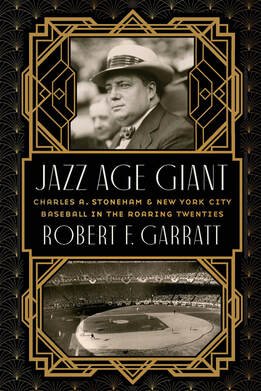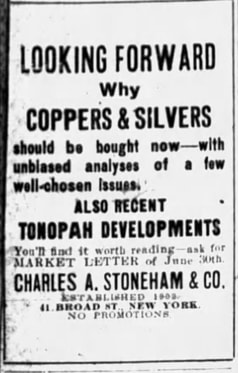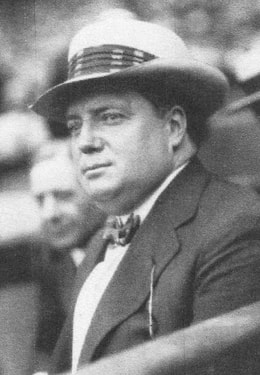
Robert F. Garratt admits up front that writing about the life of Charles Stoneham, who owned the New York Giants baseball team from 1919 until his death in 1936 at the age of 59, was “a distinct challenge.”
That is an understatement. Stoneham, who bought the New York Giants from the Brush family with partners Francis X. McQuade and Giants manager John J. McGraw, formed the National Exhibition Company.
McGraw, the face of the Giants since 1902, would win four consecutive National League pennants and two World Series titles in the early 1920s. Stoneham, meanwhile, was a shadowy figure at best, content to stay in the background. The Stoneham family would own the franchise for nearly 58 years, moving it west to San Francisco after the 1957 season before selling it to Bob Lurie in 1976.
Stoneham was a complicated figure, and Garratt makes a strong attempt at sharpening the hazy perception of the franchise owner in Jazz Age Giant: Charles A. Stoneham & New York City Baseball in the Roaring Twenties (University of Nebraska Press; $29.95; hardback; 215 pages).
 Charles Stoneham bought the Giants in 1919.
Charles Stoneham bought the Giants in 1919. Garratt, an emeritus professor of English and humanities at the University of Puget Sound, grew up in the San Francisco area and was a fan of the Giants. He initially researched the Giants’ move from New York to San Francisco and its impact on the Bay Area.
That resulted in his 2017 book, Home Team: The Turbulent History of the San Francisco Giants. The book, which examined the Giants’ relationship with San Francisco, the legacy of treacherous Candlestick and the team’s success during the 2010s, earned him finalist honors for the Seymour Medal.
He was pitted against some stiff competition for the 2018, award, including winner Jerald Podair (City of Dreams) and finalists Marty Appel (Casey Stengel), John Eisenberg (The Streak) and Debra Shattuck (Bloomer Girls).
 Robert F. Garratt is an emeritus professor of English and humanities at the University of Puget Sound.
Robert F. Garratt is an emeritus professor of English and humanities at the University of Puget Sound. Garratt takes an interesting approach to Charles Stoneham’s life, suggesting that there was a parallel between the Giants owner and Jay Gatsby, the main character in F. Scott Fitzgerald’s 1925 novel, The Great Gatsby. And he hammers the comparison home in every chapter, with a lead-in that contains a quote from the novel.
Stoneham’s lavish parties and love for the night life gave the New York tabloids ample fodder during the Prohibition Era. The fact that he had two distinct families at the same time also had tongues wagging, even during the hedonistic Roaring Twenties.
Very Gatsby-esque.
Stoneham got rich through the stock market during the first quarter of the 20th century, running “bucket shops.”
According to the Cornell Law School, bucket shops in the early 1900s were gambling operations that permitted “common people” to bet on stocks and other markets. Ordinary citizens were able to invest in markets, but their purchases were highly speculative and businessmen like Stoneham were easily able to turn a profit.
 Charles Stoneham was a sharp businessman.
Charles Stoneham was a sharp businessman. “Curb broker to be president,” the New York Tribune wrote in January 1919.
But Stoneham got out of the brokerage business by 1921, because he wanted to devote “full-time attention” to the sporting life, and specifically, the Giants, Garratt writes. The other reason was more in tune to Stoneham’s business acumen.
He realized that because the stock market was “heating up,” it would no longer favor his “bucket shop” style of investing.
“Stoneham’s company depended on a falling market to maximize its profits,” Garratt writes.
Stoneham made no secret of his relationship to men like Arnold Rothstein, the man credited as the mastermind behind the 1919 World Series Black Sox scandal. Stoneham would be indicted three times, tried for perjury and acquitted. His battles for control of the Giants with McQuade, and lawsuits over his connections to various brokerage firms that had failed, would sap the joy of winning four pennants from 1921 to 1924.
In 1924, Stoneham was indicted for mail fraud in the transfer of accounts to E.D. Dier and Company. Two years earlier, he was awash in legal battles with the firm of E.M. Fuller and Company, a business that had filed for bankruptcy and claimed that Stoneham was a silent partner.
“For the foreseeable future, Stoneham would find his world turned upside down,” Garratt writes.
The Fuller-McGee case (named for owners Edward M. Fuller and William McGee) took four years to resolve, and Stoneham would be indicted for perjury in August 1923. On the positive side, Stoneham was acquitted of mail fraud charges stemming from the Dier case in February 1925. Stoneham’s indictment for perjury in the Fuller case was dismissed in early 1927.
For those reasons, baseball executives like American League President Ban Johnson never hid his distaste for Stoneham. As a possible gambling scandal loomed on the eve of the 1924 World Series, Johnson blasted the Giants owner as “the worst influence we have in organized baseball,” according to the New York Daily News. “He and John McGraw must be driven from the game.”
Garratt notes that Stoneham and McGraw were “Jazz Age dreamers,” and the move that typified their pie-in-the-sky hopes to bring the Giants back to prominence in the late 1920s was the trade that brought Rogers Hornsby to New York.
The Giants were looking for a player to match the star power of Babe Ruth in New York, and while Hornsby could hit, his demeanor and penchant for bluntness made him few friends — if he cursed, the Rajah’s favorite four-letter word was not “tact.”
 Charles Stoneham preferred to stay in the background.
Charles Stoneham preferred to stay in the background. Stoneham’s squabbles with McQuade, which simmered during the early 1920s, boiled over in 1928 when the owner got enough votes to remove McQuade as team treasurer.
While McQuade’s removal was “personally satisfying” for Stoneham, the legal entanglements over the next six years would be a “continuing distraction” for the Giants, Garratt writes. Stoneham would prevail after appealing a lower court ruling against him as McQuade’s complaint was dismissed by the New York State Supreme Court.
On the field, Stoneham would have one final year of glory when the Giants won the 1922 N.L. pennant and then rolled past the Washington Senators in the World Series.
Stoneham also finally received some respect from his fellow owners as a “wise senior counselor,” Garratt writes. That was a far cry from his entrance into the owners’ club, where he was viewed as “an interloper, a monied, shady businessman with a fondness for horses and gambling.”
Stoneham will always remain a hazy figure, feeling no need to call attention to himself, Garratt writes. Even as his health declined, Stoneham remained a silent figure.
His business deeds, however, spoke loudly.
“As the generous host, he was often in the background,” content to let others grab the spotlight, he writes. In a city like New York, where the spotlight shone brightly on public figures, that was quite a feat.
Garratt describes Stoneham as a businessman who was “unscrupulous and ruthless,” a serial philanderer and a quasi-bigamist and a private man without a close friend.
“He was paunchily fat, and his collar met his jowls,” sportswriter Paul Gallico wrote in November 1934, comparing the Stoneham to the 1920s to a slimmer version in the 1930s.
In Garratt’s final analysis, Stoneham’s complicated and spirited life “epitomized the Jazz Age.”
Jazz Age Giant is well-researched, complemented by plenty of notes. Garratt writes simply and smoothly, explaining complicated subjects in a clear manner.
The life of Charles Stoneham may never be crystal clear, but Garratt helps bring it into focus.
 RSS Feed
RSS Feed
